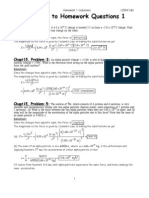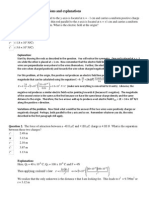Solutions To Problems: Chapter 25 Problems Appeared On The End of Chapter 25 of The
Solutions To Problems: Chapter 25 Problems Appeared On The End of Chapter 25 of The
Uploaded by
iolkos11Copyright:
Available Formats
Solutions To Problems: Chapter 25 Problems Appeared On The End of Chapter 25 of The
Solutions To Problems: Chapter 25 Problems Appeared On The End of Chapter 25 of The
Uploaded by
iolkos11Original Description:
Original Title
Copyright
Available Formats
Share this document
Did you find this document useful?
Is this content inappropriate?
Copyright:
Available Formats
Solutions To Problems: Chapter 25 Problems Appeared On The End of Chapter 25 of The
Solutions To Problems: Chapter 25 Problems Appeared On The End of Chapter 25 of The
Uploaded by
iolkos11Copyright:
Available Formats
Solutions to Problems : Chapter 25 Problems appeared on the end of chapter 25 of the Textbook
(Problem 16, 30, 42, 44, 58, 60, 66, 72)
16. Picture the Problem: Radio signals travel from Earth to a distant spacecraft. Strategy: Divide the distance by the speed of light to calculate the time for the signal to reach the craft. Solution: Calculate the time:
t = 4.5 1012 m d = = 1.5 10 4 s c 3.00 108 m/s
Insight: This time delay is 4 hours and 10 minutes. When NASA sends a signal to the craft it takes 8 hours and 20 minutes for NASA to receive a confirmation from the satellite. 30. Picture the Problem: The radiation emitted by humans has a wavelength of about 9.0 m. Strategy: Solve equation 25-4 to calculate the frequency. Then compare the frequencies to the ranges given in section 25-3 of the text. Solution: 1. (a) Calculate the frequency:
f =
3.00 108 m/s = 3.3 1013 Hz 9.0 106 m
2. (b) This frequency falls in the infrared range (1012 Hz to 4.3 1014 Hz). 42. Picture the Problem: A sinusoidal electric field has a maximum value of 65 V/m. Strategy: Divide the peak electric field by the square root of two to calculate the rms magnitude of the electric field. Solution: Calculate the rms electric field:
Erms =
Emax 2
65 V/m 2
= 46 V/m
Insight: The rms magnetic field for this wave is 1.5107 T. 44. Picture the Problem: A given electromagnetic wave has a maximum intensity of 5.00 W/m2. Strategy: Solve equation 25-10 for the maximum electric field. Solution: Calculate Emax :
2 I max = c 0 Emax
Emax =
I max = c 0
( 3.00 10 m/s )(8.8510
8
5.00 W/m 2
-12
C2 / N m 2 )
= 43.4 V/m
Insight: Verify for yourself that the maximum magnetic field for this wave is 0.145 T. 58. Picture the Problem: A 75.0-W lightbulb emits electromagnetic waves uniformly in all directions. Strategy: Use equation 14-7 to calculate the intensity of the light 3.5 m from the source. Insert the intensity into equation 25-10 to calculate the rms electric field, and then solve equation 25-9 for the magnetic field.
P 75 W Solution: 1. Divide the power by I av = av = = 0.4872 W/m 2 2 A 4 ( 3.50 m ) area:
2. Calculate the electric field:
2 I av = c 0 Erms
Erms =
Brms =
I av = c 0
( 3.00 10 m/s )(8.85 10
8
0.4872 W/m 2
12
C2 / Nm 2 )
= 13.5 V/m
3. Find the magnetic field:
Erms 13.55 V/m = = 45.2 nT c 3.00 108 m/s
Insight: The magnetic field could also have been calculated using I av = 60. Picture the Problem: A 2.8-mW laser beam has a diameter of 2.4 mm.
2 Brms (equation 25-10).
Strategy: Write the intensity as the average power divided by the area of the beam. Write the intensity in terms of the rms electric field using equation 25-10 and solve for the electric field. Solution: 1. Write I av in terms of Erms : 2. Solve for the electric field:
I av = Pav 2 = c 0 Erms A Pav Ac 0 2.8 103 W
Erms = =
(1.2 103 m) ( 3.00 108 m/s )( 8.85 1012 C 2 /N m 2 )
2
Erms = 0.48 kV/m
Insight: Note that the electric field is inversely proportional to the beam diameter. If the diameter is doubled to 4.8 mm, the electric field will drop to 240 V/m. 66. Picture the Problem: The image shows unpolarized light incident upon two polarizers, the transmission axes of which are oriented at some angle with respect to each other. Strategy: Set the intensity after the first polarizer equal to half the intensity before (equation 25-14). Use Malus Law (equation 25-13) to calculate the intensity after the second polarizer. Divide the result by the initial intensity to determine the relative intensity. Solution: 1. Calculate the intensity after the first polarizer: 2. Calculate the intensity after the second polarizer: 3. Divide the final intensity by the initial:
I1 = 1 I0 2 1 I 0 cos 2 2
I 2 = I1 cos 2 =
I2 1 = cos 2 30.0 = 0.375 I0 2
Insight: The exact orientation of the two polarizers is not important, only the relative orientation of their transmission axes.
72. Picture the Problem: The image shows unpolarized laser light passing through three polarizers. Strategy: Use equation 25-14 to calculate the intensity after the first polarizer. Then use Maluss Law (equation 25-13) to calculate the intensity as the light passes through each of the other polarizers. Solution: 1. (a) Use equation 25-14 to calculate I at point A: 2. (b) Use Maluss Law to calculate the intensity at point B: 3. (c) Use Maluss Law to calculate the intensity at point C: 4. (d) Use Maluss Law to calculate the intensity at point C, with the second polarizer removed:
I=
1 I0 2
1 I = I 0 cos 2 30.0 = 0.375 I 0 2
I = ( 0.375I 0 ) cos 2 ( 90.0 30.0 ) = 0.0938I 0
1 I = I 0 cos 2 90.0 = 0 2
Insight: The second filter rotates the polarization so that some light can pass through the third filter.
You might also like
- McDonalds - Recruitment & Selection & TrainingDocument4 pagesMcDonalds - Recruitment & Selection & TrainingIdonia CallejaNo ratings yet
- FSE10024 Introductory Physical Science: Formula SheetDocument3 pagesFSE10024 Introductory Physical Science: Formula Sheetwkquay22No ratings yet
- Solutions To Problems: Chapter 25 Problems Appeared On The End of Chapter 25 of TheDocument3 pagesSolutions To Problems: Chapter 25 Problems Appeared On The End of Chapter 25 of TheÍcaro HoffNo ratings yet
- Poynting Vector E and BDocument4 pagesPoynting Vector E and BDao ZhangNo ratings yet
- PHYS 122 Tutorial 4 (New)Document3 pagesPHYS 122 Tutorial 4 (New)smkandawire55No ratings yet
- Practice Quiz 1 SolutionsDocument5 pagesPractice Quiz 1 SolutionsNareg TerzianNo ratings yet
- PYL100 Lec14Document8 pagesPYL100 Lec14Shabeel HamNafNo ratings yet
- Task 2 - Jair DazaDocument12 pagesTask 2 - Jair DazaJair DazaNo ratings yet
- PHYSICS II SOLVED PROBLEMSDocument12 pagesPHYSICS II SOLVED PROBLEMSchiatechresearchNo ratings yet
- Electron and Photon With SolutionDocument8 pagesElectron and Photon With SolutionChiruhaasNo ratings yet
- HW 4 SolutionsDocument19 pagesHW 4 Solutionsiolkos11No ratings yet
- EM Waves QuestionsDocument15 pagesEM Waves Questionskaushik247No ratings yet
- Walker4 ISM Ch31Document36 pagesWalker4 ISM Ch31Alejandro Romero MejiaNo ratings yet
- Tares 2 - Cristian Camilo Hernandez RamirezDocument22 pagesTares 2 - Cristian Camilo Hernandez RamirezMemilio DE Las TorresNo ratings yet
- Lecture 21Document39 pagesLecture 21ekta39No ratings yet
- Coulomb's Law2Document8 pagesCoulomb's Law2Francisco BarreraNo ratings yet
- Exercise Bank Module 1 (EMR) and Module 2 (Polarization) SEM IIDocument2 pagesExercise Bank Module 1 (EMR) and Module 2 (Polarization) SEM IIAarya PatilNo ratings yet
- 24 - Electromagnetic Waves (Exercises) - Physics LibreTextsDocument10 pages24 - Electromagnetic Waves (Exercises) - Physics LibreTextsJeff GanterNo ratings yet
- 24.E_ Electromagnetic Waves (Exercises) - Physics LibreTextsDocument10 pages24.E_ Electromagnetic Waves (Exercises) - Physics LibreTextspvelardeNo ratings yet
- Lecture21 Electromagnetic WavesDocument39 pagesLecture21 Electromagnetic WavesTaqi ShahNo ratings yet
- Physics 208 Final Exam Dec. 21, 2006Document10 pagesPhysics 208 Final Exam Dec. 21, 2006Χρίστος ΠαπαναστασίουNo ratings yet
- Solved Problems-Ch23-Electric Forces New Fall 2015-2014Document21 pagesSolved Problems-Ch23-Electric Forces New Fall 2015-2014believer149No ratings yet
- Section2 8Document10 pagesSection2 8sonti11No ratings yet
- NEET 2023 Solutions Code E1Document25 pagesNEET 2023 Solutions Code E1ankurkumar296296No ratings yet
- HW 14 SolutionsDocument8 pagesHW 14 SolutionsSeleneblueNo ratings yet
- Namma Kalvi 12th Physics Model Question Papers With Answers em 220129Document158 pagesNamma Kalvi 12th Physics Model Question Papers With Answers em 220129karthi1234No ratings yet
- Namma Kalvi 10th Physics Unsolved Problems em 215624-1Document9 pagesNamma Kalvi 10th Physics Unsolved Problems em 215624-1biopharmacyNo ratings yet
- Unit 3 & 4 Problems OcnDocument38 pagesUnit 3 & 4 Problems Ocn4113 PAVITHRA KNo ratings yet
- Solution - Assignments 2Document5 pagesSolution - Assignments 2Ahmed JamalNo ratings yet
- OQP Assignment Questions and SolutionDocument30 pagesOQP Assignment Questions and SolutionSagarika Padhi Sagarika PadhiNo ratings yet
- Chapter 21 - HW Solutions and ExplanationsDocument13 pagesChapter 21 - HW Solutions and ExplanationsErin Love100% (1)
- Walker4 ISM Ch32Document31 pagesWalker4 ISM Ch32Alejandro Romero Mejia100% (1)
- Fall 2010 Qualifying Exam: - 34 - 34 - 23 - 19 A 23 8 e - 31 P - 27 N - 27 0 - 11 C e - 12 0 - 7 2 0 0 2 - 11 3 2 - 8 - 2 - 4 W - 3Document4 pagesFall 2010 Qualifying Exam: - 34 - 34 - 23 - 19 A 23 8 e - 31 P - 27 N - 27 0 - 11 C e - 12 0 - 7 2 0 0 2 - 11 3 2 - 8 - 2 - 4 W - 3rujintoNo ratings yet
- Solar Cell AssignmentDocument3 pagesSolar Cell AssignmentMashood NasirNo ratings yet
- Maxwell's Equations and Electromagnetic WavesDocument37 pagesMaxwell's Equations and Electromagnetic WavesAwadh AlharthiNo ratings yet
- JEE Main Electromagnetic Waves Previous Year Questions With Solutions PDFDocument9 pagesJEE Main Electromagnetic Waves Previous Year Questions With Solutions PDFTarun Krishna ManivannanNo ratings yet
- Laser SafetyDocument21 pagesLaser Safetymeharsaleemi.14No ratings yet
- Act 2 Coulombs LawDocument25 pagesAct 2 Coulombs LawErick Mieguel ChavezNo ratings yet
- Electromagnetic wavesDocument7 pagesElectromagnetic waveswycliffNo ratings yet
- Physics 11-02 The EM Spectrum and EnergyDocument2 pagesPhysics 11-02 The EM Spectrum and EnergyBALI RAONo ratings yet
- Annex 2 - Delivery Format - Task 2Document10 pagesAnnex 2 - Delivery Format - Task 2Diego Alejandro Cardona GiraldoNo ratings yet
- 2023-2024 - Assignment-V Unit-II-Sem I - EM TheoryDocument2 pages2023-2024 - Assignment-V Unit-II-Sem I - EM TheoryKunal KumarNo ratings yet
- Topper Sample Paper 3 Class XII-Physics Solutions: Time: Three Hours Maximum Marks: 70Document14 pagesTopper Sample Paper 3 Class XII-Physics Solutions: Time: Three Hours Maximum Marks: 70coolspanky_227053No ratings yet
- Electromangnetic Waves - PDFDocument9 pagesElectromangnetic Waves - PDFPawan KumarNo ratings yet
- SR - C12, Ch-1 - AssignmentDocument1 pageSR - C12, Ch-1 - AssignmentSumit KarnNo ratings yet
- Lecture6 Ch3 PhotonsDocument17 pagesLecture6 Ch3 PhotonsKenny H G Jiménez100% (1)
- Quantum Quest KeyDocument4 pagesQuantum Quest KeyAnonymous 7CxwuBUJz3No ratings yet
- Studymate Solutions To CBSE Board Examination 2015-2016: Series: ONS/1Document19 pagesStudymate Solutions To CBSE Board Examination 2015-2016: Series: ONS/1ujjwalgoelNo ratings yet
- Where can buy (Ebook) The Analysis and Design of Linear Circuits solutions by Roland Thomas, Albert Rosa, Gregory Toussaint ebook with cheap priceDocument71 pagesWhere can buy (Ebook) The Analysis and Design of Linear Circuits solutions by Roland Thomas, Albert Rosa, Gregory Toussaint ebook with cheap pricenazmirburjaq100% (4)
- 12-Ph 27194Document15 pages12-Ph 27194Srusti SrujanikaNo ratings yet
- Quantum Mechanics A PHY-319 Problems 3 Issue: Tuesday 24: TH NDDocument2 pagesQuantum Mechanics A PHY-319 Problems 3 Issue: Tuesday 24: TH NDShootingStarPhotonsNo ratings yet
- ch07Teoria cuánticaDocument48 pagesch07Teoria cuánticaANAYELILOLNo ratings yet
- Final (1) ModDocument2 pagesFinal (1) ModYacine KhalidNo ratings yet
- Chem's Studyguide IqDocument19 pagesChem's Studyguide IqYossuara PittiNo ratings yet
- 2013 CBSE XIIScience 4 1 SET1 SectioncDocument9 pages2013 CBSE XIIScience 4 1 SET1 SectioncShashank ShekharNo ratings yet
- Jee Main Paper 1Document55 pagesJee Main Paper 1venishettisaicharanNo ratings yet
- Solution Ch 8Document3 pagesSolution Ch 8apnayak0102No ratings yet
- Task 2 - Miguel DazaDocument12 pagesTask 2 - Miguel DazaAdrianita Garcia100% (1)
- Tugas Fisika IntiDocument35 pagesTugas Fisika IntiSharasanty PNo ratings yet
- ch36 PDFDocument11 pagesch36 PDFRodrigo S QuirinoNo ratings yet
- Problems in Quantum Mechanics: Third EditionFrom EverandProblems in Quantum Mechanics: Third EditionRating: 3 out of 5 stars3/5 (2)
- Shoulder Pain and Disability Index (SPADI)Document2 pagesShoulder Pain and Disability Index (SPADI)LindaPramusintaNo ratings yet
- Senior System Engineer in Infosys Limited, MysoreDocument6 pagesSenior System Engineer in Infosys Limited, MysoreashaNo ratings yet
- Hand Hygiene Self Assessment FrameworkDocument9 pagesHand Hygiene Self Assessment FrameworkWiDya EmiLiaNo ratings yet
- Fyp Gantt Chart: Task Name Plan Start Plan Duration Actual Start Actual Duration Percent CompleteDocument4 pagesFyp Gantt Chart: Task Name Plan Start Plan Duration Actual Start Actual Duration Percent Completeawang hazimNo ratings yet
- Linear ProgrammingDocument19 pagesLinear ProgrammingNorhapidah Mohd SaadNo ratings yet
- THEORIES of LeadershipDocument43 pagesTHEORIES of Leadershipzephyrgreg16No ratings yet
- Data Converters Data Converter Basics Professor Y. Chiu EECT 7327 Fall 2014Document39 pagesData Converters Data Converter Basics Professor Y. Chiu EECT 7327 Fall 2014Wala SaadehNo ratings yet
- Inquiries, Investigation and ImmersionDocument30 pagesInquiries, Investigation and ImmersionANNABEL MARANA100% (1)
- FUJI XPFL System Validation PlanDocument16 pagesFUJI XPFL System Validation Planasit_mNo ratings yet
- Cmmi Lessons LearnedDocument265 pagesCmmi Lessons LearnedRobert Hq100% (1)
- Fill in The Blanks Part OneDocument2 pagesFill in The Blanks Part Onestarryskies100% (1)
- Industrial Attachment ReportDocument163 pagesIndustrial Attachment ReportAtik U Bhuiyan100% (2)
- Science of The Total Environment: Xiong Ni, Yanqing Wu, Jun Wu, Jian Lu, P. Chris WilsonDocument7 pagesScience of The Total Environment: Xiong Ni, Yanqing Wu, Jun Wu, Jian Lu, P. Chris WilsonArdhi NurhakimNo ratings yet
- List Two (2) Areas of Legislative and Regulatory Context of An Organisation and Briefly Describe What They InvolveDocument19 pagesList Two (2) Areas of Legislative and Regulatory Context of An Organisation and Briefly Describe What They InvolveTanveer MasudNo ratings yet
- (Anthony Black) Political Thought in Europe, 1250 (B-Ok - Xyz) PDFDocument222 pages(Anthony Black) Political Thought in Europe, 1250 (B-Ok - Xyz) PDFaron cabonNo ratings yet
- Exercise 4: (Choice A)Document3 pagesExercise 4: (Choice A)Anonymous 5Qtn0QVDuONo ratings yet
- Varun Krishnan K (CV)Document3 pagesVarun Krishnan K (CV)Varun KrishnanNo ratings yet
- JUPEMDocument2 pagesJUPEMlokescNo ratings yet
- SHARC Processor Architecture ADSP-21060Document6 pagesSHARC Processor Architecture ADSP-21060Khaja ShaikNo ratings yet
- Ericsson Roring and Nandagopal 2007Document54 pagesEricsson Roring and Nandagopal 2007siijiiNo ratings yet
- Rae Greiner 1909 The Introduction of The Word Empathy Into EnglishDocument9 pagesRae Greiner 1909 The Introduction of The Word Empathy Into EnglishPepe PepitoNo ratings yet
- Thi Giua Ki 1 - Lan 2 - Dap AnDocument43 pagesThi Giua Ki 1 - Lan 2 - Dap AnHung NguyenNo ratings yet
- Stirling CycleDocument6 pagesStirling CycleChristian_Joe__9147No ratings yet
- The Nature of CivilizationDocument4 pagesThe Nature of CivilizationMr. FieldsNo ratings yet
- Theories of RetailDocument24 pagesTheories of RetailSiddhartha DeshmukhNo ratings yet
- Body and Soul in Platos AnthropologyDocument7 pagesBody and Soul in Platos AnthropologyJoséRamónOrrantiaCavazosNo ratings yet
- Lexical Analyzer (Compiler Contruction)Document6 pagesLexical Analyzer (Compiler Contruction)touseefaq100% (1)
- Quantifying Dynamic Stability and Maneuverability in Legged LocomotionDocument9 pagesQuantifying Dynamic Stability and Maneuverability in Legged Locomotionisbro1788No ratings yet

























































































